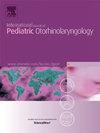Is COVID-19 infection during pregnancy a risk for congenital hearing loss?
IF 1.2
4区 医学
Q3 OTORHINOLARYNGOLOGY
International journal of pediatric otorhinolaryngology
Pub Date : 2025-01-01
DOI:10.1016/j.ijporl.2024.112191
引用次数: 0
Abstract
Objective
Infections during pregnancy can increase the risk of congenital hearing loss. This population-based study investigated the effect of birthing parent COVID-19 infection during pregnancy on risk of congenital hearing loss in infants.
Methods
Records of infants born in 2022 were reviewed via a retrospective clinical audit of a universal state-wide newborn hearing screening program in Victoria, Australia. The number and timing of COVID-19 infections during pregnancy were collected via self-report at the time of the hearing screen. Infant records (n = 75,330) were divided into birthing parent infection group (n = 25,547, 33.9 %), and non-infection group (n = 49,783, 66.1 %). Group differences in screen and diagnostic audiology results were estimated by general linear regression models with a binomial distribution.
Results
Birthing parent and infant characteristics were similar across groups. Comparable proportions of infants obtained a refer result on their newborn hearing screen, requiring referral to diagnostic audiology (infection group: 1.4 %, 95%CI 1.2–1.5 versus non-infection group: 1.3 %, 95%CI 1.2–1.4). The proportion of infants diagnosed with any type and degree of hearing loss was also similar (infection group: 0.6 %, 95%CI 0.5–0.7 versus non-infection group: 0.6 %, 95%CI 0.6–0.7).
Conclusion
This epidemiological study is the largest to date and demonstrates that infants whose birthing parent reported COVID-19 infection during pregnancy were not at increased risk of obtaining a refer result on their newborn hearing screen, nor at increased risk of congenital hearing loss. Specific protocols or guidelines to manage the newborn hearing screening pathway of infants born to a parent with COVID-19 during pregnancy are not supported by this study's findings.
孕期感染 COVID-19 是否会导致先天性听力损失?
目的:妊娠期感染可增加先天性听力损失的风险。这项基于人群的研究调查了分娩父母在怀孕期间感染COVID-19对婴儿先天性听力损失风险的影响。方法:通过对澳大利亚维多利亚州全国新生儿听力筛查项目的回顾性临床审计,回顾了2022年出生的婴儿的记录。通过听力筛查时的自我报告收集妊娠期间COVID-19感染次数和时间。新生儿记录75,330例,分为分娩父母感染组(n = 25,547例,占33.9%)和未感染组(n = 49,783例,占66.1%)。用二项分布的一般线性回归模型估计筛查和诊断听力学结果的组间差异。结果:各组出生父母和婴儿特征相似。相当比例的婴儿在新生儿听力筛查中获得转诊结果,需要转诊到诊断听力学(感染组:1.4%,95%CI 1.2-1.5;非感染组:1.3%,95%CI 1.2-1.4)。诊断为任何类型和程度的听力损失的婴儿比例也相似(感染组:0.6%,95%CI 0.5-0.7与非感染组:0.6%,95%CI 0.6-0.7)。结论:这项流行病学研究是迄今为止规模最大的一项研究,表明亲生父母在怀孕期间报告COVID-19感染的婴儿在新生儿听力筛查中获得转诊结果的风险没有增加,先天性听力损失的风险也没有增加。本研究结果不支持对怀孕期间感染COVID-19的父母所生婴儿的新生儿听力筛查途径进行管理的具体方案或指南。
本文章由计算机程序翻译,如有差异,请以英文原文为准。
求助全文
约1分钟内获得全文
求助全文
来源期刊
CiteScore
3.20
自引率
6.70%
发文量
276
审稿时长
62 days
期刊介绍:
The purpose of the International Journal of Pediatric Otorhinolaryngology is to concentrate and disseminate information concerning prevention, cure and care of otorhinolaryngological disorders in infants and children due to developmental, degenerative, infectious, neoplastic, traumatic, social, psychiatric and economic causes. The Journal provides a medium for clinical and basic contributions in all of the areas of pediatric otorhinolaryngology. This includes medical and surgical otology, bronchoesophagology, laryngology, rhinology, diseases of the head and neck, and disorders of communication, including voice, speech and language disorders.

 求助内容:
求助内容: 应助结果提醒方式:
应助结果提醒方式:


